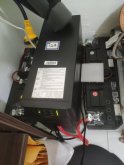For background, see this thread:

 diysolarforum.com
diysolarforum.com
tl;dr: I'm wanting to assemble a 24v LiFePO4 battery pack of around 20 Ah capacity to replace SLA batteries in a UPS.
I realize this is quite a bit lower capacity than most folks around here are interested in, but I'm not interested in powering a RV or home, but rather some network equipment. I'm getting tired of wearing out SLA battery packs on my UPS, and wanting to replace them with LiFePO4. Form factor isn't really important (i.e., I'm not expecting to fit them in the same space as the SLA batteries), though "compact" is always nice. Low-temperature protection isn't an issue--these will be indoors in a climate-controlled room. Super-rugged construction isn't particularly important for the same reason, though I'll probably build or 3D-print a battery box to keep everything together. Overcharge/overdischarge protection is important--UPSs aren't known for treating batteries well. Common port is important; the UPS would charge and load through the same connection.
At full rated output (1500 VA), and ignoring losses in the inverter, the UPS would be drawing 62.5 amps from the batteries. However, with the equipment currently connected (which I don't expect to change significantly), it's only at about 10% capacity.
Right now, I'm thinking a 8S 80A Daly BMS and maybe these cells:

 www.aliexpress.com
www.aliexpress.com
But I'm open to suggestions on either part, especially the cells. What haven't I thought of?

LiFePO4 for UPS battery replacement?
tl;dr: I'm getting annoyed with the SLA batteries in my UPSs, and thinking about replacing them with LiFePO4 packs (either preassembled or DIY), mainly for increased life span. I have two UPSs that are in need of batteries. For those who aren't familiar, UPSs typically use packs of 12V, 5-9Ah...
tl;dr: I'm wanting to assemble a 24v LiFePO4 battery pack of around 20 Ah capacity to replace SLA batteries in a UPS.
I realize this is quite a bit lower capacity than most folks around here are interested in, but I'm not interested in powering a RV or home, but rather some network equipment. I'm getting tired of wearing out SLA battery packs on my UPS, and wanting to replace them with LiFePO4. Form factor isn't really important (i.e., I'm not expecting to fit them in the same space as the SLA batteries), though "compact" is always nice. Low-temperature protection isn't an issue--these will be indoors in a climate-controlled room. Super-rugged construction isn't particularly important for the same reason, though I'll probably build or 3D-print a battery box to keep everything together. Overcharge/overdischarge protection is important--UPSs aren't known for treating batteries well. Common port is important; the UPS would charge and load through the same connection.
At full rated output (1500 VA), and ignoring losses in the inverter, the UPS would be drawing 62.5 amps from the batteries. However, with the equipment currently connected (which I don't expect to change significantly), it's only at about 10% capacity.
Right now, I'm thinking a 8S 80A Daly BMS and maybe these cells:

98.0US $ |lifepo4 3.2v 20Ah lithium battery Lithium iron phosphate deep cycle for DIY 36V 48V 72V 40AH scooter bike motorcycle inverter|Rechargeable Batteries| - AliExpress
Smarter Shopping, Better Living! Aliexpress.com
But I'm open to suggestions on either part, especially the cells. What haven't I thought of?



